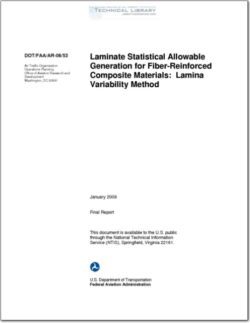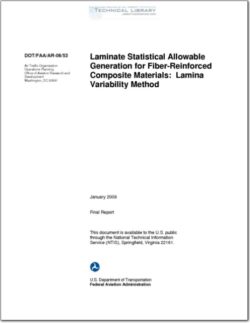DOT-FAA-AR-06-53

- Version
- 432 Downloads
- 5.47 MB File Size
- 1 File Count
- March 23, 2016 Create Date
- March 23, 2016 Last Updated
Laminate Statistical Allowable Generation for Fiber-Reinforced Composite Materials Lamina Variability Method, NCAMP Data
- Toray T700SC-12K-50C/#2510 - Carbon/Epoxy Prepreg Plain Weave Fabric - 193 g/m²
- Toray T700GC-12K-31E/#2510 - Carbon/Epoxy Prepreg Unidirectional Tape - 150 g/m²
- FiberCote T700/E765 24K Graphite Unidirectional Tape 150 g/m²
- FiberCote T300/E765 3K Plain Weave Fabric 190 g/m²
- Advanced Composites Group (ACG), Inc. AS4C/MTM45 12K Unidirectional Tape 145 g/m²
- Advanced Composites Group (ACG), Inc. AS4C/MTM45 6K Five Harness (5HS) Fabric 375 g/m²

With the application of composite materials in aircraft structural components, material
qualification requirements have been a costly burden to airframe manufacturers. Substantiation
of such structures often requires analysis and multiple levels of building-block tests. Typically,
as one proceeds up the building block and becomes more confident in the analytical design
methods, the number of samples or replicates is reduced since structural complexity increases.
For example, the greatest number of specimens is usually tested at the lowest level when factors
such as batch variability and environment are included in the test. Typically, the number of
specimens approaches 1000 mechanical tests at this lower level. In contrast, only one test article
is used at the highest level of the building block, which usually consists of a full-scale test.
As the complexity of higher—level testing increases, more variables are introduced; i.e., fastener
holes and multidirectional laminates. Due to the increased cost of higher-level testing, the
number of samples must be reduced. Currently, there is no standardized statistical methodology
that allows progression up the pyramid of tests with a concurrent reduction of the number of tests
while maintaining statistical reliability established at the lower replicate level. Therefore,
conservative approaches are exercised at the higher—level, building-block tests to be able to use
the material variability of lower levels to represent the higher levels. Because a reduction in the
number of samples results in excessively low or overly conservative material allowables, this
research program explores the use of lamina-level variability to generate B—basis allowables for
fiber-reinforced laminated composites. A multibatch laminate database was created to form
baseline B-basis values. Then, B-basis allowables were obtained from single-batch data sets and
compared with multibatch data to investigate the statistical reliability of the proposed small-
sample B-basis method—Lamina Variability Method (LVM). This investigation included six
material systems from three prepreg manufacturers: Toray Composites, FiberCote Industries,
and Advanced Composites Group. In addition to the proposed methodology, two additional
small-sample, B-basis methods proposed by Steve Ward were compared. Analysis of lamina and
laminate test data showed that using LVM produced conservative B—basis allowables that were
about 90% of the three-batch laminate allowables.
| File | Action |
|---|---|
| DOT-FAA-AR-06-53 Laminate Statistical Allowable Generation for Fiber-Reinforced Composite Materials Lamina Variability Method.pdf | Download |
Comment On This Post